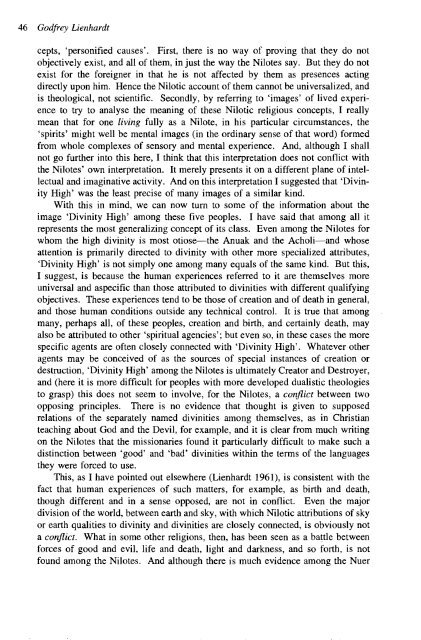godfrey lienhardt - Institute of Social and Cultural Anthropology ...
godfrey lienhardt - Institute of Social and Cultural Anthropology ...
godfrey lienhardt - Institute of Social and Cultural Anthropology ...
Create successful ePaper yourself
Turn your PDF publications into a flip-book with our unique Google optimized e-Paper software.
46 Godfrey Lienhardt<br />
cepts, 'personified causes'. First, there is no way <strong>of</strong> proving that they do not<br />
objectively exist, <strong>and</strong> all <strong>of</strong> them, in just the way the Nilotes say. But they do not<br />
exist for the foreigner in that he is not affected by them as presences acting<br />
directly upon him. Hence the Nilotic account <strong>of</strong> them cannot be universalized, <strong>and</strong><br />
is theological, not scientific. Secondly, by referring to 'images' <strong>of</strong> lived experience<br />
to try to analyse the meaning <strong>of</strong> these Nilotic religious concepts, I really<br />
mean that for one living fully as a Nilote, in his particular circumstances, the<br />
'spirits' might well be mental images (in the ordinary sense <strong>of</strong> that word) formed<br />
from whole complexes <strong>of</strong> sensory <strong>and</strong> mental experience. And, although I shall<br />
not go further into this here, I think that this interpretation does not conflict with<br />
the Nilotes' own interpretation. It merely presents it on a different plane <strong>of</strong> intellectual<br />
<strong>and</strong> imaginative activity. And on this interpretation I suggested that 'Divinity<br />
High' was the least precise <strong>of</strong> many images <strong>of</strong> a similar kind.<br />
With this in mind, we can now turn to some <strong>of</strong> the information about the<br />
image 'Divinity High' among these five peoples. I have said that among all it<br />
represents the most generalizing concept <strong>of</strong> its class. Even among the Nilotes for<br />
whom the high divinity is most otiose-the Anuak <strong>and</strong> the Acholi-<strong>and</strong> whose<br />
attention is primarily directed to divinity with other more specialized attributes,<br />
'Divinity High' is not simply one among many equals <strong>of</strong> the same kind. But this,<br />
I suggest, is because the human experiences referred to it are themselves more<br />
universal <strong>and</strong> aspecific than those attributed to divinities with different qualifying<br />
objectives. These experiences tend to be those <strong>of</strong> creation <strong>and</strong> <strong>of</strong> death in general,<br />
<strong>and</strong> those human conditions outside any technical control. It is true that among<br />
many, perhaps all, <strong>of</strong> these peoples, creation <strong>and</strong> birth, <strong>and</strong> certainly death, may<br />
also be attributed to other 'spiritual agencies'; but even so, in these cases the more<br />
specific agents are <strong>of</strong>ten closely connected with 'Divinity High'. Whatever other<br />
agents may be conceived <strong>of</strong> as the sources <strong>of</strong> special instances <strong>of</strong> creation or<br />
destruction, 'Divinity High' among the Nilotes is ultimately Creator <strong>and</strong> Destroyer,<br />
<strong>and</strong> (here it is more difficult for peoples with more developed dualistic theologies<br />
to grasp) this does not seem to involve, for the Nilotes, a conflict between two<br />
opposing principles. There is no evidence that thought is given to supposed<br />
relations <strong>of</strong> the separately named divinities among themselves, as in Christian<br />
teaching about God <strong>and</strong> the Devil, for example, <strong>and</strong> it is clear from much writing<br />
on the Nilotes that the missionaries found it particularly difficult to make such a<br />
distinction between 'good' <strong>and</strong> 'bad' divinities within the terms <strong>of</strong> the languages<br />
they were forced to use.<br />
This, as I have pointed out elsewhere (Lienhardt 1961), is consistent with the<br />
fact that human experiences <strong>of</strong> such matters, for example, as birth <strong>and</strong> death,<br />
though different <strong>and</strong> in a sense opposed, are not in conflict. Even the major<br />
division <strong>of</strong> the world, between earth <strong>and</strong> sky, with which Nilotic attributions <strong>of</strong> sky<br />
or earth qualities to divinity <strong>and</strong> divinities are closely connected, is obviously not<br />
a conflict. What in some other religions, then, has been seen as a battle between<br />
forces <strong>of</strong> good <strong>and</strong> evil, life <strong>and</strong> death, light <strong>and</strong> darkness, <strong>and</strong> so forth, is not<br />
found among the Nilotes. And although there is much evidence among the Nuer
















